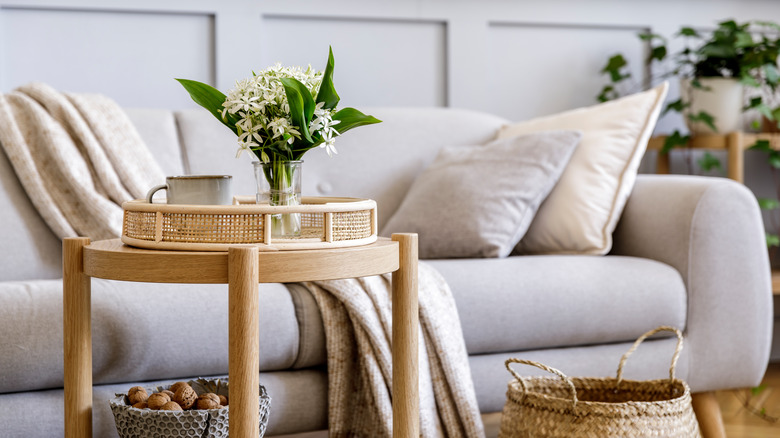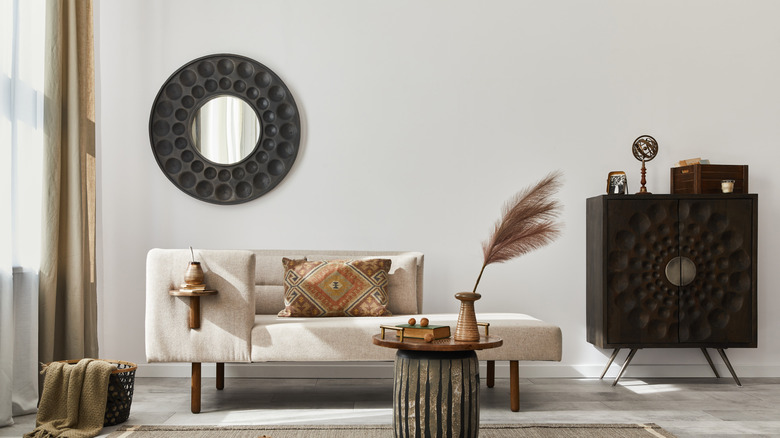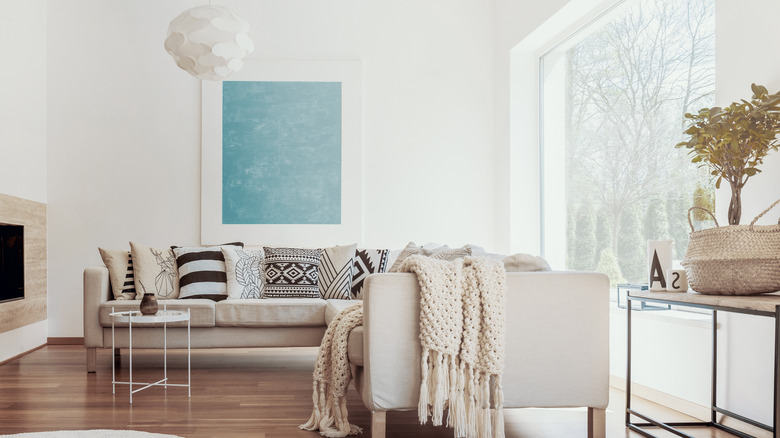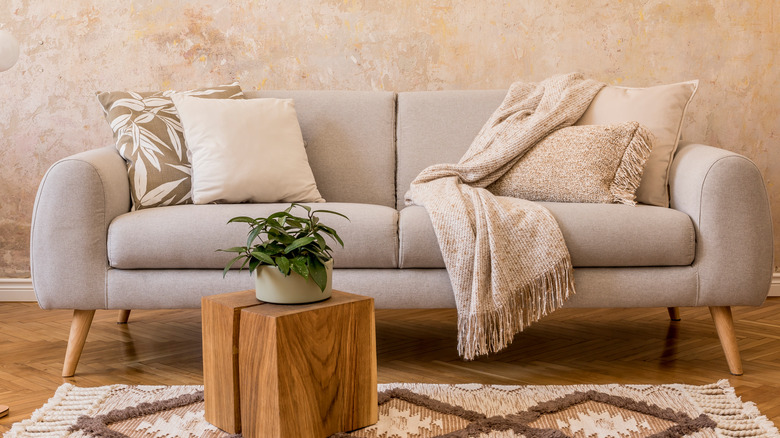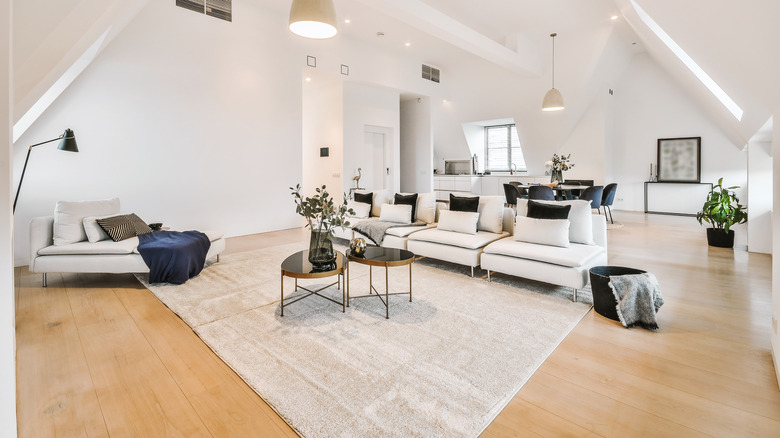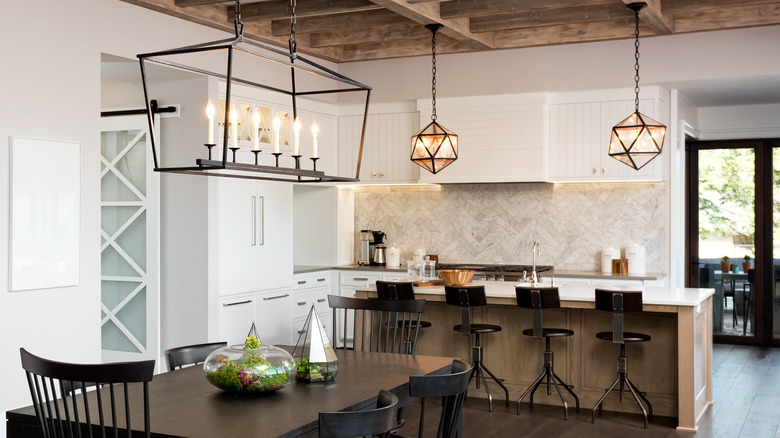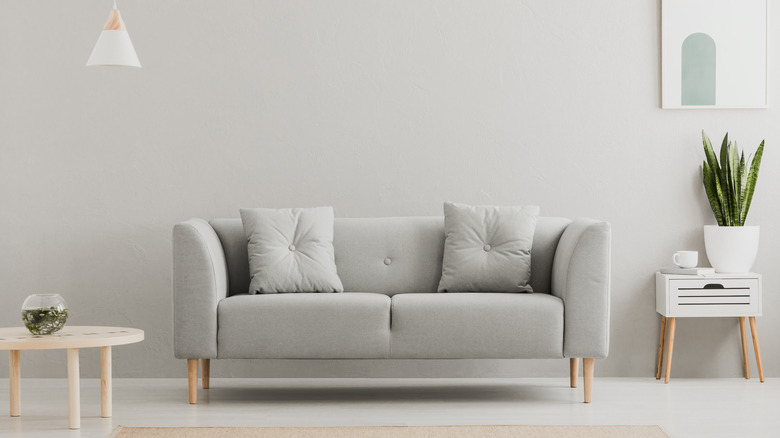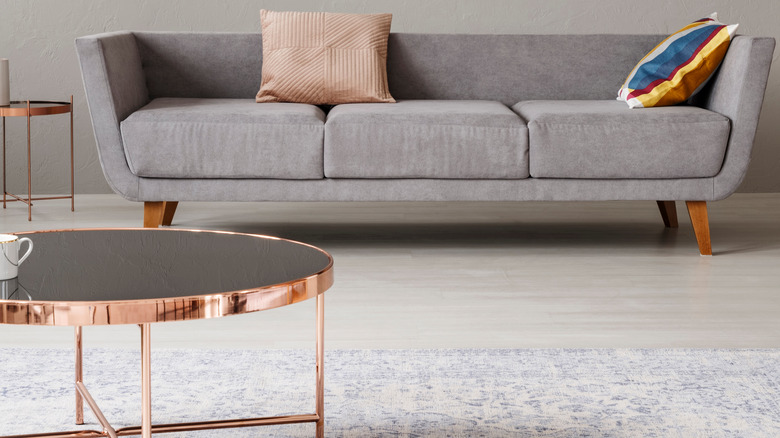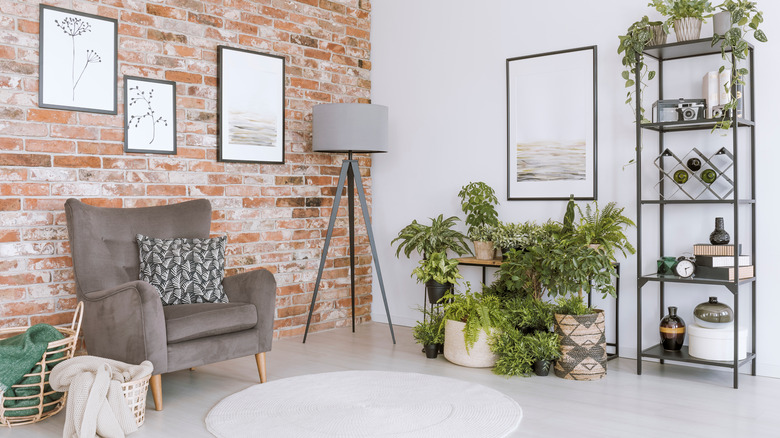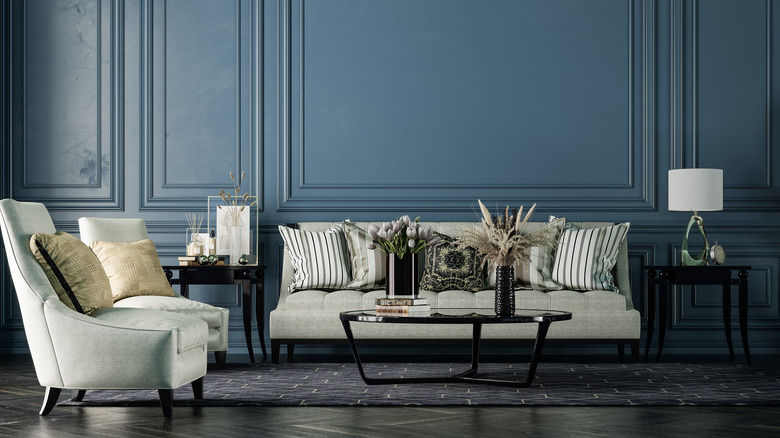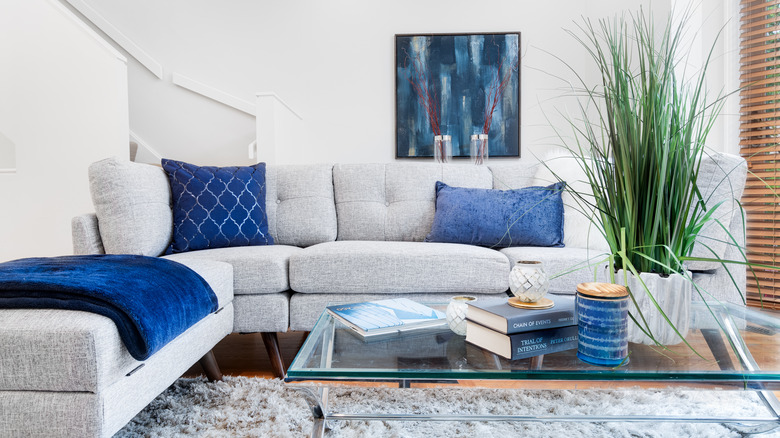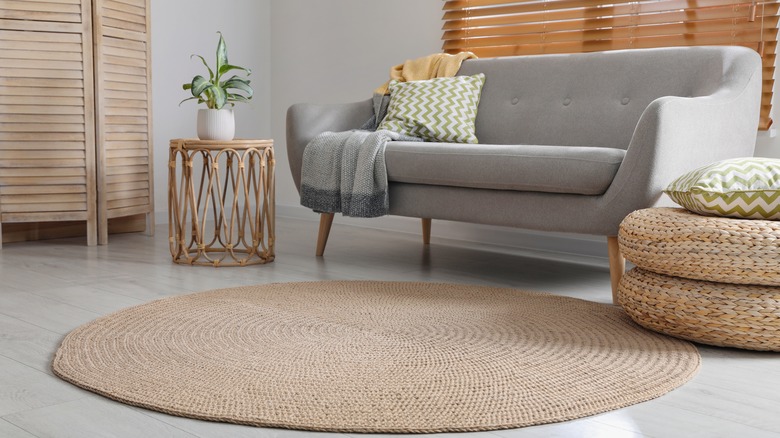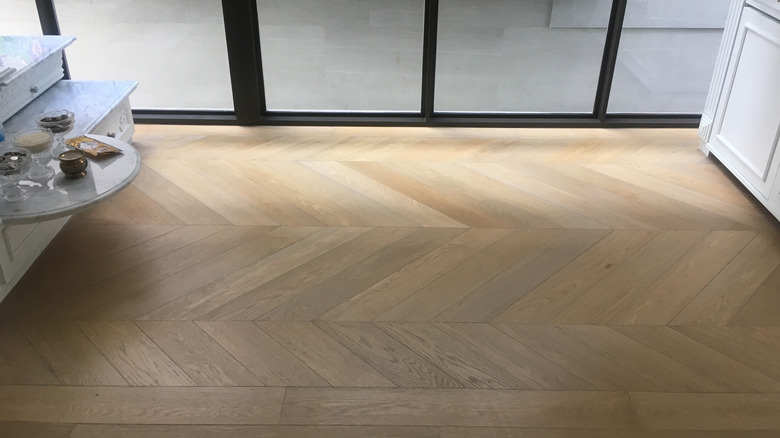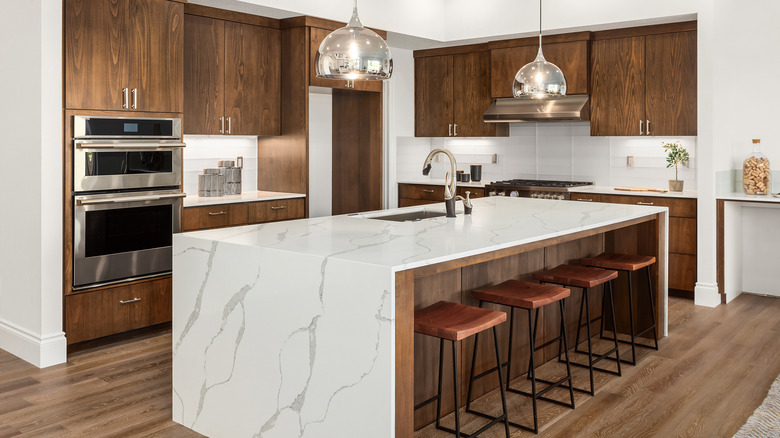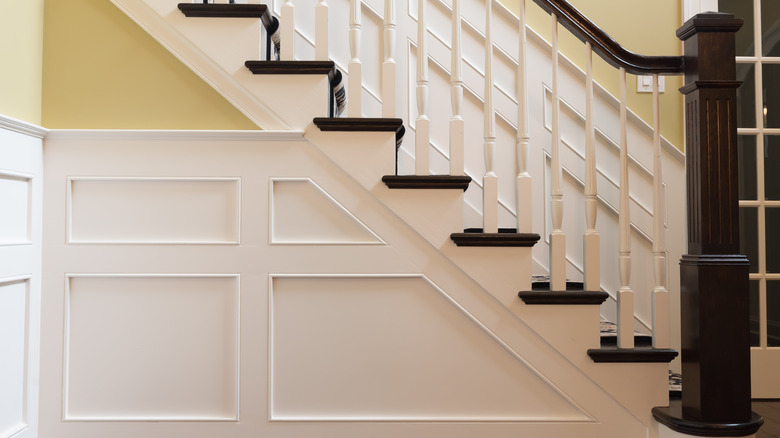The Ultimate Guide To Transitional Decor
Are you struggling to decide on the best style for your home and coming up short? Transitional decor may be the way to go, especially if you like modern and traditional design elements. According to Apartment Therapy, transitional decor combines modern and traditional interior design. "It combines curves with straight lines, it's airy and polished, and it's textured but not cluttered," says Renee DiSanto of Park & Oak Interior Design. Traditional decor uses antique furniture, accent pieces, patterned wallpaper, dramatic chandeliers, and draperies. Modern design, however, features minimalism, neutral paint colors, and open floorplans.
You might think it would be hard to combine these two styles because they are so different. However, blending them requires only a few simple tips and tricks. Choose minimalist items in the living room and comfortable, grander options in the bedroom. Layer glass, tile, and wood materials to make this design style work. A neutral palette, a clear focal point, and a mix of new and the old will also help your home strike the balance that defines transitional decor (via MasterClass). Read on for more tips on creating a beautiful transitional home.
Use neutral tones
Neutral tones complement any style because you can pair them with almost anything. Contrary to popular belief, they're not dull. According to The Spruce, neutral refers to a lack of color. True neutrals include beige, ivory, taupe, black, gray, and white. Many of these colors have undertones, which you can accentuate with the rest of your decorating choices.
Examples of undertones include pink, tan, gold, or gray in beige. Whites may contain undertones of yellow, blue, or peach. These undertones need to be taken into consideration when you are decorating. Use one shade of gray on your walls and a different hue in your flooring planks. You could even choose a lighter shade for the wall and a darker version of the same color for your upholstery, rugs, or carpeting. Or pair different tones with pops of other colors or neutrals (MasterClass). Think about partnering your gray walls with sage green upholstery or carpeting. No matter which colors you choose, the lighting in a room is essential when choosing your colors. The tone, type, and wattage of the lighting scheme determine the warmth of your undertones.
Add colorful art or accents
Want to add some color to those neutral walls? Colorful wall art is one way to go. Another trick is to add accent pieces or furniture that complement and contrast against your walls and the rest of the room.
According to Wall Art Prints, both contrasting and complementing pieces can work. They are simply variations on a theme. For instance, a piece of art in a deep shade of aqua would pair beautifully with beige walls and a sage green sofa because the colors are complementary. On the other hand, you could pair the wall and sofa with abstract art, including red, orange, and purple, as long as it contains blues and greens that match the remaining decor. Art serves several purposes in a room. It provides a focal point and makes a room appear finished (via MyMove). Additionally, it provides pops of color in the otherwise neutral palette of transitional decor.
Fill your furniture with cushions
Another way to add color and texture to a transitional space is to decorate your room with pillows. The best spots to fill with pillows are sofas, couches, and beds because they have a large canvas. According to Architectural Digest, you can choose to use just a few accent pillows or pile them high. Just remember to leave enough room for people to sit and socialize.
You don't have to stick to color and size when selecting your perfect pillows. Experiment with different textures to see what looks best. Use a group of colors in the same category, play with patterns, and match the furniture. However, your cushions don't have to be the same color as the couch you're putting them on. In many cases, this trend can serve you well. Instead of varying the colors, patterns, and texture of your cushions, just select ones that are different from the couch you're adding them to. Choose an anchor color for your throw pillows and highlight one color (via MyDomaine). Find similarly colored items that will accentuate but not outshine the focal point. Vary the sizes and patterns of your cushions to create a standout room.
Texturize your rooms with carpet or area rugs
There are many ways you can use carpets to decorate your home. Unlike rustic or more traditional styles, carpeting works well in transitional decor. The good news is that rugs and carpets come in various colors, styles, shapes, and sizes. Use them to add color and texture to your room. According to Architectural Digest, selecting your carpet or rugs should be the first thing you do when decorating a room. Start by choosing your first layer and then add to it as you would when deciding what to wear. Flooring will be the first decision you make. If you choose wood or laminate floors, you can liven them up with area rugs.
Area rugs are generally a better option for your floors for several reasons (via The Spruce). For example, they are easier to clean and can be updated if you get bored with a particular design. If you choose to change the color scheme in your room at some point down the road, area rugs are more convenient to swap out than wall-to-wall carpets. When selecting area rugs, consider the color, style, and size. The rug should be large enough to cover the floor entirely underneath the furniture in your room. Try to leave at least 24 inches from the wall on each side of your rug. Whenever possible, use them in the highest traffic areas of your home.
Install modern lighting
Modern lighting pairs beautifully with traditional design elements to create a transitional home. According to Houzz, a classic room should incorporate modern lighting. Adding something modern and unexpected can transform a space entirely. However, they recommend repeating colors or design elements, dressing up more casual designs, and mixing earthy and industrial pieces. If, for instance, you already have brass hardware on some of your antique furniture, a modern brass lamp could complement the room. If you don't have a finish to repeat, you could aim to replicate a shape that already exists in the room. For example, a circular lamp in a circular room can work wonders.
If you don't know which style to choose, consider your lighting. Mid-century modern decor and lighting remain popular, despite being around since the late 1940s. Mid-century lighting like Sputnik chandeliers, hanging pendants, hourglass fixtures, sculptural pieces, and retro industrial choices in vibrant hues are all great choices (via The Spruce). If your furniture is primarily classic or antique, find some standard lighting options for your nightstand and dresser, but choose a modern chandelier to hang over the bed.
Choose furniture with simple lines
Modern furniture is known for its sleek design. Old-world style has always been more ornate. However, you can find simple antique pieces to create transitional spaces. Newer items also work so long as they are simple, clean, and utilitarian.
If you're looking to incorporate this design style into your home, you need to add simple, clean lines. According to Paradigm Interiors, clean lines are unbroken, uninterrupted lines. Contemporary design often uses rectilinear lines. Curvilinear lines are typically associated with femininity and are used in traditional furnishings to celebrate opulence. Styles associated with curvilinear lines are Baroque, Art Deco, Mid-Century Modern, and Post-Modernist. However, curvilinear lines can be clean when they are unadorned. There are plenty of ways to add this style to your home. If you are looking for larger pieces or want to make a statement, places like Da Vinci Designs take custom orders for wall units and other shelving units.
Bring on the bling with metallic accents
You can go big with metallics or sprinkle them sparingly throughout your transitional home. According to Livspace, metallic accents work with many different decorating styles. They can draw the eye or serve as conversation starters. Vintage mirrors, vases, and candles all come in metallic shades. Most of these can be found in silver, gold, bronze, or copper, so there's an option to fit your color palette.
You can mix different metals, or you can choose to stick with one. Rubbed bronze makes a charming statement if you aren't ready to move on to shinier materials like gold or silver. Pendant lights are another simple, classic way to add this element to your home. Since they are trendy, there are always new ways to add metals to your design scheme. You can find them in accent pillows, kitchenware, and backsplash designs. Go for more straightforward options, like tables with metal legs or metallic finishes (via Spacejoy). Candelabras, lamps, and bar carts also come in metals, allowing you to use these accents in every room of your home.
Pick suede, chenille, and leather fabrics
Soft fabrics are lovely additions to transitional environments. Suede, chenille, and leather were used in traditional styles and remain popular in modern interior design. According to SFGate, a leather couch makes a bold statement in any living room. However, you will have to plan accordingly if you're going for this style. Many of the neutral colors transitional decor is known for will be overpowered by the typical dark colors in leather couches. Sage green or light amber are better options, and you can counter these colors with other accents in the room.
You could also soften the look of the couch by adding throw pillows. Warm colors or cushions with metallic accents complement leather couches. Or you could add a different fabric into the mix by incorporating a velvet, suede, or chenille chair. Suede also works wonderfully on headboards, footboards, and curtains (via Houzz).
Blend masculine and feminine
Blending masculine and feminine design is a transitional style of its own. Mixing these two styles is not so different from incorporating contemporary and antique elements. Aspects like leather, which tends to be masculine, blend well with suedes and chenilles, which carry a more feminine vibe.
These aren't the only options for blending. According to Professional Staging, it's best to vary colors, patterns, accessories, and furniture. Darker colors tend to be more masculine. Adding lighter, more feminine colors creates a transitional look. Likewise, abstract patterns are more masculine and layer with smoother, floral designs. Or you could choose stripes or circles, which are gender-neutral. Combining masculine and feminine components will create a look that blends modern and traditional artfully. Curved lines and soft fabrics tend to be feminine, whereas simple, rough edges are masculine. These styles are similar to contemporary and traditional, so mixing them is effortless.
Incorporate pops of color
Add a striking pop of color to your room with an accent wall. Minor elements like colorful rugs, vibrant artwork, vases, and books also work great. According to Havenly, when you start with a neutral backdrop and simple furniture, it's easy to add pops of color.
Striped rugs, flowers, and accent furniture are simple ways to do this. Artwork is an even simpler one. As a plus, people are less likely to tire of neutral shades, so using them on the walls and in your furniture choices is wise. Choosing less permanent options that are colorful makes them easier to swap out, should the mood strike you. If art and rugs aren't to your taste, you could choose a textile instead. Brightly colored throws on neutral couches or chairs could be the splash you need (MyDomaine). Or you could choose a chair in a spectacular color that calls attention to itself. Adding a pop of color to your room can be as complex or easy as you wish.
Go with a minimalist approach
Minimalism includes the best elements of transitional decor. This style favors clean lines, simple furniture, and the marriage of masculine fabrics and feminine decoration. As Décor Aid explains, the minimalist decorating style accentuates the artistic elements of your architecture. Decluttering should be your first step if you switch to minimalism from any other design trend.
While some think minimalist design is cold, there are ways to make it appear warmer. Adding texture is the first step (via Spacejoy). Personal touches make a tremendous difference to the warmth of any room within your home. An essential element in minimalist decor involves creative storage choices that keep items out of sight, like baskets and boxes. In a traditional minimalist style, squared-off edges are preferable. In transitional decor, some rounded edges will work. Even oval shapes will fit when you combine these two different decorating styles.
Choose hexagonal, chevron, or light-toned hardwood
Light floors work well with transitional decor because they complement minimalist styling. However, you don't have to lay them in traditional lines. If you're looking for something more visually interesting, choose tiles in a chevron or herringbone pattern. You might wonder about the difference between these two patterns and why they work in this style. According to Architectural Digest, chevron planks meet in perfect, aligned points, while the herringbone pattern is more staggered.
Or you could select hexagonal tiles. Tile with hexagonal shapes is very on-trend and comes in many varieties (via Lushome). If you're decorating with white tiles, go for textured designs or geometric printing. Deavita offers hexagonal tiles with gold trim, so you can also use metallic accents with this design element. They look lovely when combined with other finishes as well. Mixing wood planks with hexagonal tiles creates a charming flooring option.
Serve up colored glassware and quartz in the kitchen
Quartz countertops are incredibly trendy at the moment, and they work wonderfully with your transitional decor. According to HGTV, while some countertops feature quarried slabs of quartz, it is common to find engineered versions. These use 95% ground quartz combined with a polymer resin. This mixture creates a durable and easy-to-clean surface.
Another transitional trend is colored glassware. Glasses come in many different shapes, colors, and sizes. However, your options aren't limited to drinking glasses. Ikea offers a green glass pitcher that would look lovely in a glass-faced cabinet in your kitchen. Glass-faced cabinets are also an excellent choice for a home decorated in the transitional style. Stained, leaded, or frosted glass are great cabinet options (via Dengarden). If you have these materials in your home but want to switch them up, line them with decorative paper or fabric for a fresh look.
Emphasize wainscotting
According to Bob Vila, wainscotting is a decorative wall paneling covering the bottom half of a wall. Some examples are beadboard, raised paneling, board and batten, and picture frame molding. Board and batten fit transitional styles well because of the clean lines. Some homes have wainscotting or millwork already in place. If your home has wainscotting, accentuate it with a fresh coat of neutral or bright paint. If you don't have wainscotting, you can add it to any room and instantly elevate your home.
There are many different styles and ideas for wainscotting and millwork. For example, there are traditional neutral colors and much less common ones, like juniper, in a striped pattern (via The Finished Space). Chair rail comes in different widths, and you can use traditional wainscotting panels from floor to ceiling. These options will give your home a bit of old-world charm without damaging its modern-day beauty.
